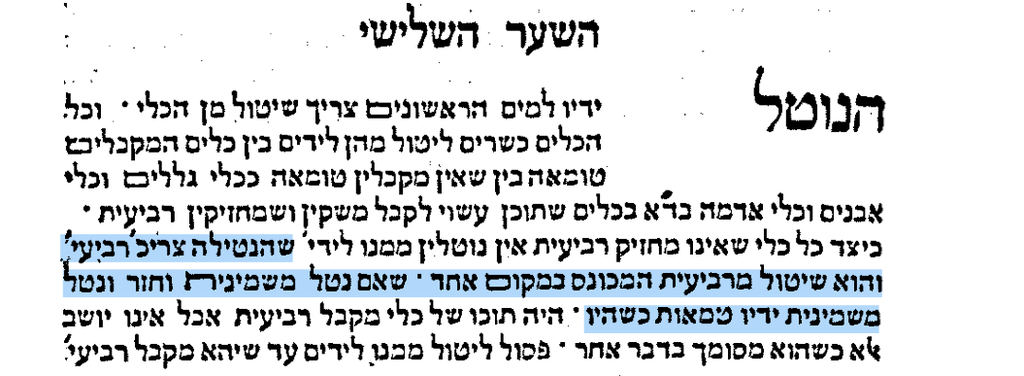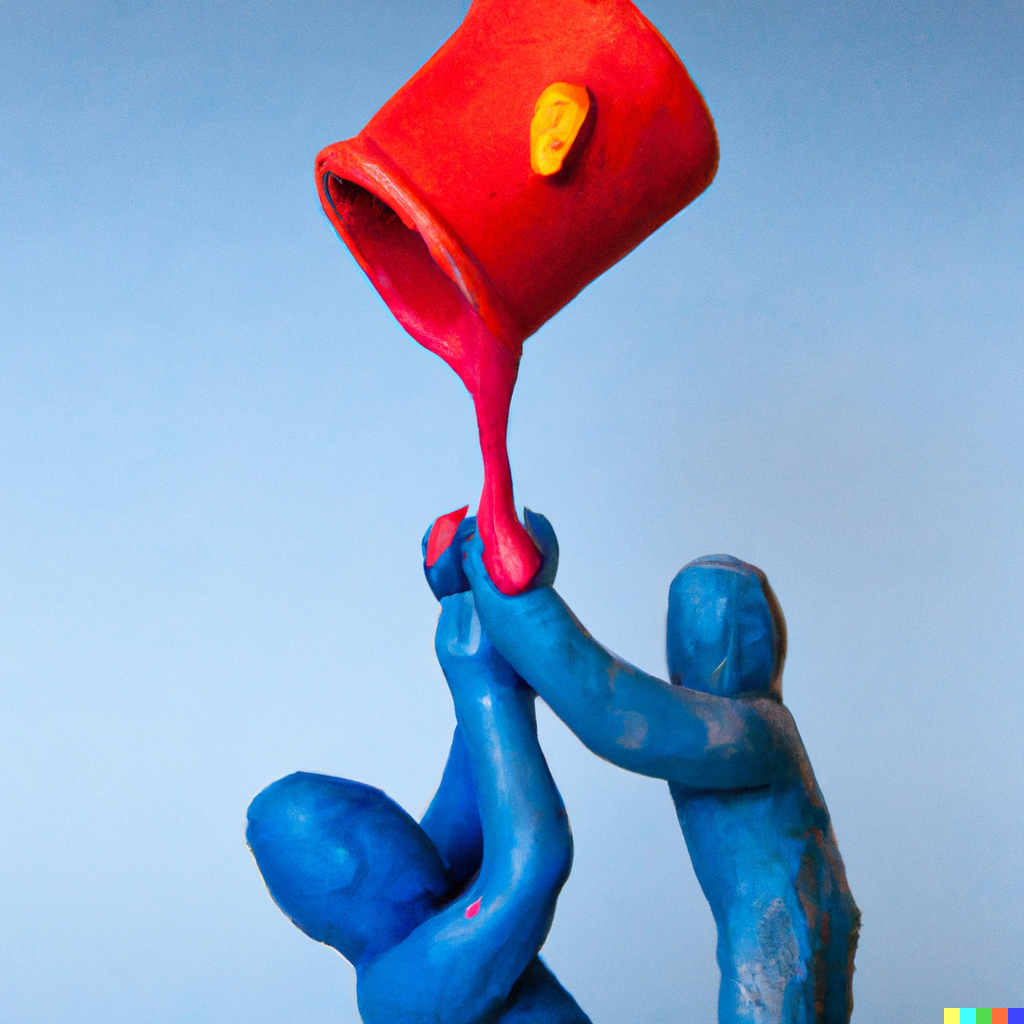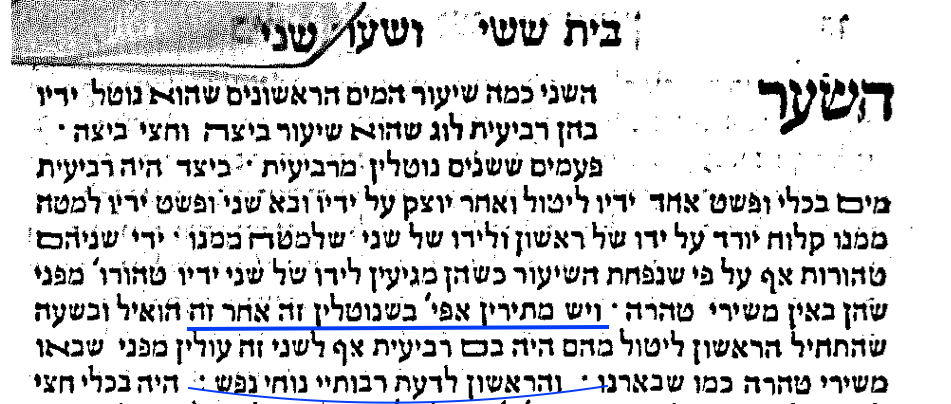(יג) צריך שיהא במים רביעית והני מילי לאחד אבל לב' שבאו ליטול כאחד האחרון א"צ ואפילו בזה אחר זה...
The term reviis is short for "reviis halog", a quarter of a log.
1 log is 6 beitzim. (Source: Manachos 89a)
1 beitzah is 1.9 fl. oz.
1 log is this 11.4 fl. oz. (1.9*6)
A quarter of a log (reviis) is 2.85 fl.oz.
Let's get a picture as to how much a reviis is in practical terms.
Based on Biur Halacha (271:13) in a different context in Hil. Kiddush, the shiur is 3.8 fl. oz.
Other opinions put a reviis between 3 and 5.5 fl. oz.
For a point of reference:
- That's a little less than a half full average styrofoam cup (8 oz.)
- The standard measurement of a "cup" (as found in recipes or on measuring cups) is 8 fl. oz. Therefore, a revi’is is approximately one half of a cup.
ואמר רבא כלי שאין בו רביעית אין נוטלין ממנו לידים.
איני והאמר רבא כלי שאין מחזיק רביעית אין נוטלין ממנו לידים - הא מחזיק אע"ג דלית ביה!
לא קשיא הא לחד הא לתרי, דתניא מי רביעית נוטלין לידים לאחד ואפילו לשנים.
And Rava says: With regard to a vessel that does not have a quarter-log of water in it, one may not wash his hands with it.
The Gemara asks: Is that so? But doesn’t Rava say: With regard to a vessel that cannot contain a quarter-log of water, one may not wash his hands with it. It may be consequently inferred that as long as the vessel can contain a quarter-log, one may use it even if it does not currently have a quarter-log in it?
The Gemara answers: This is not difficult; this former statement, requiring a quarter-log of actual water, is referring to washing for one person, whereas that latter statement, requiring only that the vessel have a capacity of a quarter-log, is referring to washing for two people. If a vessel originally contained a quarter-log of water, then even if less than that amount remains after one person has washed his hands, a second individual may use the remainder, which is considered fit based on the water’s original volume. As it is taught in a baraita: With a quarter-log of water, one may wash the hands of one individual, and even those of two.
Mishna Berura here begins by mentioning the correct procedures to wash netilas yadayim with the different amounts of water available to him.
1. In Mishna Berura he explains the way to wash min hadin with a reviis.
2. In Shaar Tzion he says the recommended way to wash lechatchila with a reviis.
3. Mishna Berura ends off the most recommended way to wash with an abundance of water.
1. The way to wash min hadin with a reviis
Mishna Berura says that min hadin one do one act of pouring of a reviis of water on both hands.
This is inferred from a halacha from later on:
(א) הגבהה ושפשוף הידים בנטילה ובו י סעיפים:
הנוטל צריך להגביה ידיו (דהיינו ראשי אצבעותיו) למעל' שלא יצאו מים חוץ לפרק ויחזרו ויטמאו את הידים. הגה: ...והיינו כשאינו נוטל כל היד עד מקום חבור היד עם הזרוע אבל אם נוטל עד שם א"צ להגביה ידיו (ויש חולקים בזה) וכן אם שפך על שתי ידיו רביעית בפעם אחת כיון דאין שם מים טמאים כלל א"צ להגביה ידיו...
2. The recommended way to wash lechatchila with a reviis
But lechatchila one should pour the reviis in two pourings over each of his hands.
This is inferred from the next seif in the above quoted siman.
(ב) הנוטל ידיו שופך עליהם קצת מהרביעית להסיר מהם הלכלוך וכל דבר שחוצץ ואח"כ שופך עליהם פעם שניה.
וגם אלו המים הם טמאים ואח"כ שופך עליהם פעם שלישית לטהר המים שעל גבי הידים...
The reason this is more recommended than the first method is because although when one washes once upon each hand, his hands become tahor, however, the water that is now on his hands has become tameh and there still exists the possibility that this water may splash onto terumah and make it tameh, and thus inedible for Kohanim to eat (which is itself an issur, see (Bamidbar 18:8) and Sanhedrin 83a-b)
Therefore, by washing a second pouring onto that original water, one purifies that tameh water and eliminates that second concern of water contaminating the terumah.
3. The most recommended way to wash with an abundance of water
But if a person has abundant water, he should pour even more than a reviis in the prescribed manner of alternating between both hands with two pourings.
This is inferred from a halacha from a few simanim ago.
(י) אע"פ ששיעורם ברביעית [פירוש רביעית הלוג דהיינו שיעור ביצה וחצי] יוסיף ליטול בשפע דאמר רב חסדא אנא משאי מלא חפני מיא ויהבי לי מלא חפני טיבותא:
---
(10) Even though the minimum amount of water is a reviis [that is, a quarter lug. In other words: the volume of one and a half eggs], you should add more water, as Rav Hisda said "I washed a full hand of water and I was given a full hand of good [wealth].
---
Additional halachos concerning the need for shiur reviis in washing
1. From the simple reading of Shulchan Aruch, one needs a reviis in total for both hands.
However, some hold that one needs to pour a reviis on each hand.
Shaar Tzion brings proof that the first opinion seems to be more correct, however in Mishna Berura he ends off that one who wants to avoid any issues should pour a reviis on each hand to keep all shittos.
2a. Since the halacha is that you need a reviis for two hands, one could have thought that if one only has one hand or if one hand was previously tahor*, that you only need 1/8 of a reviis, this is not the case because the minimum "shiur tahara" is a reviis.
2b. Similarly, one could have thought that someone who has small hands doesn't need a full reviis, this is not the case, even he will need a full reviis.
א' הנוטל בידו אחת ואחד הנוטל בשתי ידיו ואחד ידו של גדול ואחד ידו של קטן צריך ליטול מי רביעית.
[It is the same] whether one pours over one hand or whether one pours over two hands, and whether it is the hand of an adult or whether it is the hand of a minor -- one needs to pour a quarter-log.
*We find a similar concept in regards to the washing at the Kiyyor. The Or HaChaim says:
(1) חק עולם. אפילו עלה מבית הטבילה שנטהר מטומאה חמורה חוקה חקק ה', ולזה הוצרך לומר פעם ב'. ולא ימותו הא אם לא רחצו הגם שעלו מטבילה הרי הם במיתה ולא תועיל טבילה:
---
1) חק עולם, an eternal law. Even though the priest may have just emerged from immersing himself in a ritual bath in order to purify himself from a more severe category of impurity, this does not relieve him of the need to wash his hands and feet from the water of the כיור. The Torah warns the priest for the fifth time not to risk the death penalty to warn him that the ritual immersion did not replace the commandment to wash their hands and feet before either entering the Sanctuary or approaching the copper altar in the courtyard to perform service therein
---
3. Because of this "shiur tahara" one needs to wash with a full reviis at once; he cannot split two washings into 2 pourings of an with of a lug one after the other. (seif 14 in the name of Rashba in Toras HaBayis HaKatzar)

...ובלבד שלא יפסיק הקילוח כיצד היה רביעית מים בכלי ופשט אחד ידיו ואחר יוצק על ידיו ובא שני ופשט ידיו למטה ממנו סמוך ליד הראשון וקילוח יורד על ידו של ראשון ולידו של שני שלמטה ממנו ידי שניהם טהורות אע"פ שפיחת שיעור הרביעית כשהם מגיעים לידיו של שני ידיו טהורות מפני שהם באים משיורי טהרה...

There are a couple discussions in this unusual washing going on here.
1. The need for the water to be continuously falling between each person washing & the intention to have this "doubles" washing.
2. The distance between each person's hands.
3. The differences in the measurements based on the amount of people (next section)
1. The need for the water to be continuously falling between each person washing and the intention to have this doubles washing
According to this shitta, even if the water is continuous, it is still necessary that they are both having kavanna for this one reviis to work for both of them.
To fully understand the requirement according to these Rishonim (Rashba and Ritva) for why the water cannot stop, we need to first understand a Klal called chibbur nitzok.
(ו) מִקְוֶה שֶׁיֶּשׁ בּוֹ אַרְבָּעִים סְאָה מְכֻוָּנוֹת, יָרְדוּ שְׁנַיִם וְטָבְלוּ זֶה אַחַר זֶה, הָרִאשׁוֹן טָהוֹר, וְהַשֵּׁנִי טָמֵא. רַבִּי יְהוּדָה אוֹמֵר, אִם הָיוּ רַגְלָיו שֶׁל רִאשׁוֹן נוֹגְעוֹת בַּמַּיִם, אַף הַשֵּׁנִי טָהוֹר...
(6) If a mikveh contained forty seahs exactly and two persons went down and immersed themselves one after the other, the first becomes clean but the second remains unclean. Rabbi Judah says: if the feet of the first were still touching the water, the second also becomes clean...
Bartenura there explains this din based on Gud Achis, not chibbur nitzok? Also we don't go like R' Yehuda according to Bartenura?
(ב) אף השני טהור. דאמרינן גוד אחית, והוי כאילו המים שהעלה הראשון בגופו הן מחוברין למי מקוה ולא נחסר משיעורו כלום. ופירשו בגמרא דחגיגה [דף י״ט] דלא טיהר רבי יהודה אלא במעלות דרבנן, כגון שהיה טהור לחולין וטבל להיות טהור למעשר, או שהיה טהור למעשר וטבל להיות טהור לתרומה. אבל לעלות מטומאה גמורה לטהרה, דברי הכל טמא. ואין הלכה כר׳ יהודה:
--
(2) אף השני טהור – for we say that we lower [the partition], for it is as if the water that the first person brought up on his body is attached to the waters of the Mikveh, and it (i.e., the Mikveh) is not lacking anything from its measurement. And they explained in the Gemara (i.e., Talmud) of [Tractate] Hagigah [19a] that Rabbi Yehuda did not purify other than according to the gradations of the Rabbis, as for example that he was ritually pure for non-sacred things and he immersed in order to become ritually pure for tithes, or that he was ritually pure for tithes and he immersed in order to become pure for priest’s due/heave offerings. But to ascend from complete ritual impurity to purity, he is ritually impure to everyone. But the Halakha is not according to Rabbi Yehuda.
--
By Mikva, the of chibbur nitzok allows the second person to become tahor since the first person was still in the mikvah as the second person was going in, thus connecting the tevilla of both of them to be a tevilla in a full 40 seah mikvah.
Here too, since although they aren't washing at the exact same time (the second person is coming afterwards), we can apply the klal of chibbur nitzok to say that the second person was also washing from a full reviis cup.
Although the comparison is slightly different, nevertheless, since netilas yadayim is DeRabbanan, we were maykel to generously apply the din here too.
מי רביעית ניטלים ידים לאחד ואפי' לשנים. ופרישנא דקא אתו משירי טהרה. איכא למידק, ה"ד, אי משו תרוייהו בחדא זימנא, מאי שירי טהרה איכא הכא דמאן מינייהו בתרא, ואי בזה אחר זה כי אתו מכח רביעית מאי הוי השתא מיהא ליכא רביעית. ויש לומר דמיירי בזה אחר זה ובלבד שלא יפסיק הקלוח, וקל הוא שהקילו בנטילה. וכן פירש הרמב"ן ז"ל ומשום דהוי נצוק חבור כדאמר לענין מקוה (מקואות פ"ז, מ"ו) כל זמן שרגליו של ראשון במים השני טהור, והיינו דקתני בסיפא בדוכתא רבי יוסי אומר ובלבד שלא יפחות לאחרון שבהן מרביעית, אלמא בזה אחר זה מיירי.
There are those who argue (brought in Rashba's work Toras HaBayis HaKatzar) and say that the need for the water to be flowing continuously between both of them is unnecessary. Even if they are washing one after the other in the most literal sense, it is okay for them tot share a single reviis as long as they both had in mind to do this "doubles" washing from the start.
...ויש מתירים אפי' כשנוטלים זה אחר זה הואיל ובשעה שהתחיל הא' ליטול מהם היה בהם רביעית גם לשני זה עולים מפני שבאו משיורי טהרה

2. The distance between each person's hands
...ופשט ידיו למטה ממנו סמוך ליד הראשון וקילוח יורד על ידו של ראשון ולידו של שני שלמטה ממנו
The wording of the Shulchan Aruch seems to imply that they need to position their hands close together in order to consider them one unit in regards to this Netilas Yadayim. (If ones hands would be further away, it would be like washing from ones friends Netila which we said was passul at the end of seif 11, ayin sham)
(כט) [כט] סמוך ליד הראשון וכו'. דחשיבו כיד אחת אבל כשמרוחקת מידי הראשון לא עלתה נטילה לפי שהוא נוטל במי רחיצת חבירו, כן כתבו בית יוסף רש"ל וב"ח, כתב מגן אברהם דוקא כשנתכוונו ליטול שניהם כאחת:
However, Beis Yosef has doubt as to the necessity of close proximity between both of their hands.
ואפשר שאם ידי השני מרוחקות מידי הראשון לא עלתה לו נטילה לפי שהוא נוטל במי רחיצת חבירו אלא כשידי השני סמוכות לידי הראשון מיירי דחשבינן להו כיד אחת:
Although their hands should be close together, they should not be pressed to closely together in order for the water to reach the surface of each of their hands. The likeliness of this being overlooked is more prevalent to a case of numerous people washing together (as this is mentioned in that context at the end of the seif), but it applies to all cases.
(פ) (פ) שירפו וכו' - היינו שלא ידחקו זה על זה:
נוֹטְלִין אַרְבָּעָה וַחֲמִשָּׁה זֶה בְצַד זֶה אוֹ זֶה עַל גַּבֵּי זֶה, וּבִלְבַד שֶׁיְּרַפּוּ שֶׁיָּבֹאוּ בָהֶם הַמָּיִם:
Water may be poured over the hands of four or five persons, each hand being by the side of the other, or being one above the other, provided that the hands are held loosely so that the water flows between them.
ולא נאמר כי המים היורדין מידיו העליונים הם משקין טמאים לפי שהם מים ראשונים והידים אשר תחתיהן לא יטהרו במים ההם כיון שהוא טמא לפי שהם כולם במדרגת יד אחת אנו חושבין אותם ובתנאי שלא ידחקו ידיהם שלא יכנסו בהם המים כדי שלא תהיה חציצה:



